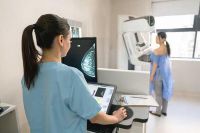About-cancer/screening/screening-tests/zh
Contents
- 1 篩檢
- 1.1 有效的癌症篩查測試
- 1.2 結腸鏡檢查,乙狀結腸鏡檢查和糞便檢查(高靈敏度糞便潛血檢查和糞便DNA檢查)
- 1.3 小劑量螺旋計算機斷層掃描
- 1.4 Mammography
- 1.5 Pap test and human papillomavirus (HPV) testing
- 1.6 Other Screening Tests
- 1.7 Alpha-fetoprotein blood test
- 1.8 Breast MRI
- 1.9 CA-125 test
- 1.10 Clinical breast exams and regular breast self-exams
- 1.11 PSA test
- 1.12 Skin exams
- 1.13 Transvaginal ultrasound
- 1.14 Virtual colonoscopy
- 1.15 More Information
- 1.16 Related Resources
篩檢
有效的癌症篩查測試
癌症篩查測試旨在及早發現癌症,在症狀產生之前以及何時更容易成功治療。 有效的篩選測試是:
- 儘早發現癌症
- 減少定期接受篩查的人死於癌症的機會
- 具有更多的潛在利益大於危害。 (篩查測試的可能危害包括出血或其他物理損傷,不準確的測試結果以及過度診斷,即診斷不會造成問題且不需要治療的癌症。)
結腸鏡檢查,乙狀結腸鏡檢查和糞便檢查(高靈敏度糞便潛血檢查和糞便DNA檢查)
已經顯示了幾種篩選測試可以降低死於大腸癌的風險。 結腸鏡檢查和乙狀結腸鏡檢查不僅可以及早發現結腸直腸癌,而且可以從一開始就幫助預防該疾病。 這是因為這些測試可以發現異常結腸生長(息肉),可以在患癌之前將其清除。 專家組通常建議對處於大腸癌平均風險中的人進行50至75歲年齡範圍的一項檢查以進行篩查。有關更多信息,請參閱《檢測大腸癌和息肉的試驗》技術說明書和PDQ®大腸癌篩查摘要 。
小劑量螺旋計算機斷層掃描
該篩查肺癌的試驗顯示可以減少55至74歲的重度吸煙者的肺癌死亡率。有關更多信息,請參見國家肺癌篩查試驗頁面和PDQ®肺癌篩查摘要。
Mammography
This method to screen for breast cancer has been shown to reduce deaths from the disease among women ages 40 to 74, especially those over age 50. For more information, see the Mammograms fact sheet and the PDQ® Breast Cancer Screening summary.
Pap test and human papillomavirus (HPV) testing
These tests, which can be used both alone and in combination, can lead to both early detection and prevention of cervical cancer. They prevent the disease because they allow abnormal cells to be found and treated before they become cancer. Testing is generally recommended to begin at age 21 and to end at age 65 in women who have had adequate prior screening and are not otherwise at high risk for cervical cancer. For more information, see the Pap and HPV Testing fact sheet and the PDQ® Cervical Cancer Screening summary.
Other Screening Tests
Screening tests that have not been shown to be effective may still be offered, especially to people who are known to be at increased risk of cancer.
Alpha-fetoprotein blood test
This test is sometimes used, along with ultrasound of the liver, to try to detect liver cancer early in people at high risk of the disease. For more information, see the PDQ® Liver (Hepatocellular) Cancer Screening summary.
Breast MRI
This imaging test is often used for women who carry a harmful mutation in the BRCA1 gene or the BRCA2 gene; women with these mutations have a high risk of breast cancer, as well as increased risk for other cancers. For more information, see the BRCA Mutations: Cancer Risk and Genetic Testing fact sheet and the PDQ® Breast Cancer Screening summary.
CA-125 test
This blood test, which is often done together with a transvaginal ultrasound, may be used to try to detect ovarian cancer early, especially in women with an increased risk of the disease. Although this test can help to diagnose ovarian cancer in women who have symptoms and can be used to evaluate the recurrence of cancer in women previously diagnosed with the disease, it has not been shown to be an effective ovarian cancer screening test. For more information, see the PDQ® Ovarian Cancer Screening summary.
Clinical breast exams and regular breast self-exams
Routine examination of the breasts by health care providers or by women themselves has not been shown to reduce deaths from breast cancer. However, if a woman or her health care provider notices a lump or other unusual change in the breast, it is important to get it checked out. For more information, see the PDQ® Breast Cancer Screening summary.
PSA test
This blood test, which is often done along with a digital rectal exam, can detect prostate cancer at an early stage. However, expert groups no longer recommend routine PSA testing for most men because many prostate cancers detected with PSA testing are not deadly, and early detection and treatment of PSA-detected cancers has not been shown to reduce the chance of dying from prostate cancer. For more information, see the Prostate-Specific Antigen (PSA) Test fact sheet and the PDQ® Prostate Cancer Screening summary.
Skin exams
Doctors often recommend that people who are at risk for skin cancer examine their skin regularly or have a health care provider do so. Such exams have not been shown to decrease the risk of dying from skin cancer, and they may lead to overtreatment. However, people should be aware of changes in their skin, such as a new mole or a change to an existing mole, and report these to their doctor promptly. For more information, see the Common Moles, Dysplastic Nevi, and Risk of Melanoma fact sheet and the PDQ® Skin Cancer Screening summary.
Transvaginal ultrasound
This imaging test, which can create pictures of a woman’s ovaries and uterus, is sometimes used in women who are at increased risk of ovarian cancer (because they carry a harmful BRCA1 or BRCA2 mutation) or of endometrial cancer (because they have a condition called Lynch syndrome). But it has not been shown to reduce deaths from either cancer. For more information, see the PDQ® Ovarian Cancer Screening summary and the PDQ® Endometrial Cancer Screening summary.
Virtual colonoscopy
This test allows the colon and rectum to be examined from outside the body. Although it has not been shown to reduce deaths from colorectal cancer and may reveal possible problems outside the colon that then need to be investigated further, this test may be recommended if it is the only colorectal cancer screening test a person finds acceptable. For more information, see the Tests to Detect Colorectal Cancer and Polyps fact sheet and the PDQ® Colorectal Cancer Screening summary.
More Information
For complete information about screening tests by cancer type, including tests that are being developed and tests that were used in the past, see the PDQ® Cancer Information Summaries: Screening/Detection (Testing for Cancer)
Related Resources
In an Era of Precision Medicine, Testing New Approaches to Breast Cancer Screening

